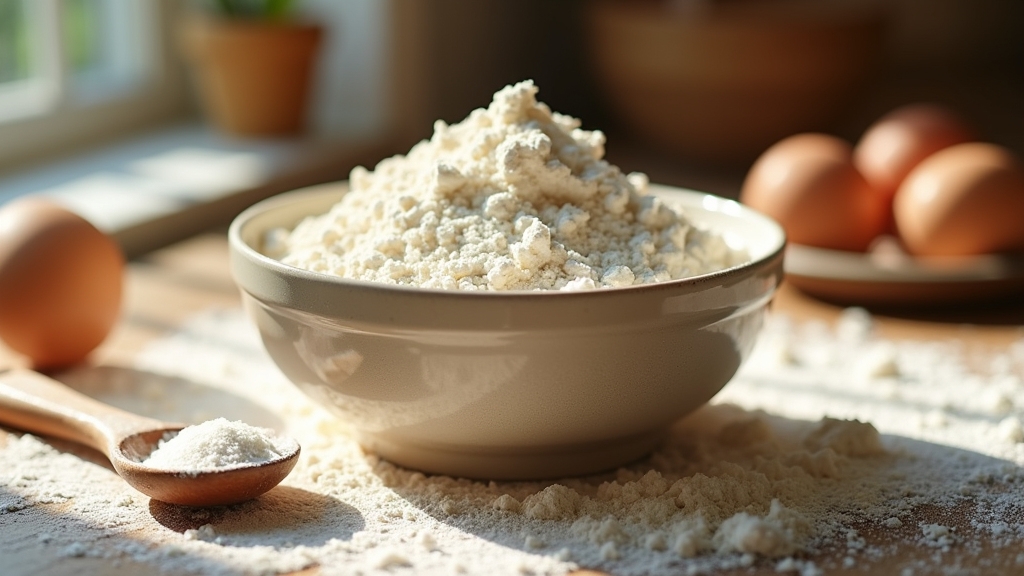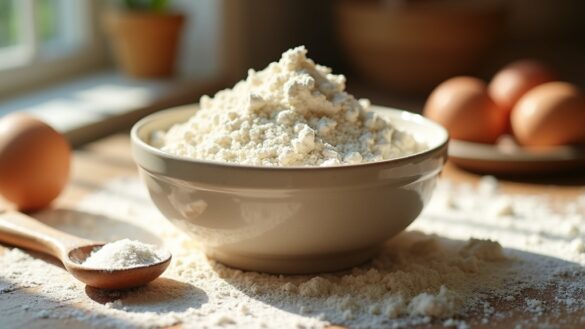To make cake flour at home, I mix one cup of all-purpose flour with two tablespoons of cornstarch. This combination creates a lighter flour with a lower protein content, perfect for tender cakes. I sift the mixture to aerate it, which helps achieve that delicate crumb. Remember, accurate measurements and gentle mixing are key to a fluffy cake! If you want to explore more tips for successful baking, I’ve got plenty to share.
History
When I think about the history of cake flour, I can’t help but marvel at how it evolved over centuries to become a staple in baking. Originally, bakers used all-purpose flour, but as the demand for lighter, fluffier cakes grew, they began refining their methods. By the late 19th century, the advent of industrial milling allowed for finely milled flour, which had a lower protein content than standard flour. This innovation led to the creation of cake flour, specifically designed for delicate confections. The texture and consistency made it ideal for cakes, ensuring they rose beautifully. Understanding this baking history not only deepens my appreciation for cake flour but also inspires me to experiment and innovate in my own baking adventures.
Recipe
Cake flour is a versatile ingredient that can elevate your baking by providing a tender crumb and fine texture to cakes, cupcakes, and other baked goods. Unlike all-purpose flour, which has a higher protein content, cake flour is milled from soft wheat and has a lower protein percentage, allowing for a lighter and fluffier result. Making your own cake flour at home is simple and requires just two ingredients: all-purpose flour and cornstarch.
Using homemade cake flour can make a significant difference in the final product, especially in delicate cakes like chiffon or sponge. By substituting commercially available cake flour with this homemade version, you can maintain the desired texture and structure of your baked goods. Follow the easy steps below to create your own cake flour, and enjoy the satisfaction of baking with a freshly prepared ingredient.
Ingredients:
- 1 cup all-purpose flour
- 2 tablespoons cornstarch
Instructions:
To make cake flour, start by measuring out 1 cup of all-purpose flour and removing 2 tablespoons from it. Replace the removed flour with 2 tablespoons of cornstarch, then sift the mixture together at least twice. Sifting not only combines the ingredients but also aerates the flour, giving it a lighter texture. Once your cake flour is ready, it can be used immediately or stored in an airtight container for future baking projects.
Extra Tips:
When using homemade cake flour, it’s crucial to remember that this mixture may not perform exactly like store-bought cake flour in all recipes. Always check the specific requirements of your recipe, as some may call for additional adjustments in liquid or leavening agents. Additionally, if you don’t have cornstarch on hand, you can also substitute it with arrowroot or potato starch for a similar effect. Always verify to sift your cake flour before measuring to avoid any lumps and achieve the best results in your baking.
Cooking Steps
When it comes to making the perfect cake flour, every step counts. I’ll guide you through measuring and sifting the flour, adding cornstarch for that light, airy texture, and carefully incorporating baking powder. Let’s whisk everything together gently to create a blend that’s sure to elevate your baking game!
Step 1. Measure Flour Accurately
Although measuring flour may seem straightforward, getting it right is essential for achieving the perfect cake texture. I’ve found that using precise measuring techniques makes all the difference. Here’s how I do it:
- Use a kitchen scale: Weighing flour guarantees accuracy. A cup of flour can vary widely in weight.
- Spoon and level: If you’re using cups, spoon flour into your measuring cup, then level it off with a knife.
- Avoid packing: Don’t tap the cup or pack the flour down; this can lead to too much flour.
- Check weight conversion: If a recipe specifies weight, stick to it for consistent results.
With these tips, you’ll guarantee your cake flour is measured perfectly every time!
Step 2. Sift Flour Thoroughly
After measuring flour accurately, the next step is to sift it thoroughly. This process is vital for achieving that light, airy texture we crave in cake flour. I usually opt for a fine mesh sieve, as it allows me to incorporate air into the flour while breaking up any clumps. If you’re feeling adventurous, try experimenting with different sifting techniques—like the whisk method, which can add a delightful fluffiness. Remember, not all flour types behave the same; for instance, cake flour is softer and finer than all-purpose flour, making it important to sift to prevent a dense cake. So, let’s get sifting and elevate our baking game! Your cakes will thank you for it.
Step 3. Add Cornstarch for Lightness
To achieve that feather-light texture in your cakes, I always recommend adding cornstarch to your cake flour. The cornstarch benefits are incredible, as it helps to create a delicate crumb that elevates your cake texture to bakery-quality.
Here’s how to incorporate it seamlessly into your baking:
- Measure out 1 cup of all-purpose flour.
- Remove 2 tablespoons of flour from the cup.
- Replace those tablespoons with 2 tablespoons of cornstarch.
- Sift the mixture together thoroughly.
This simple addition not only lightens your cake but also enhances its overall structure. You’ll notice a remarkable difference in the fluffiness of your baked goods. So, go ahead, give it a try, and experience the magic of cornstarch!
Step 4. Incorporate Baking Powder Carefully
When I bake, I know that incorporating baking powder carefully is vital for achieving that perfect rise and texture in my cakes. Different baking powder types, like single-acting and double-acting, react uniquely, affecting how my cake rises. I start by measuring the right amount based on my recipe, making sure I don’t overdo it, as excess can lead to a bitter taste and a dense texture. I sift the baking powder with my flour mixture, allowing even distribution. This step is important because it guarantees that every bite of my cake has that delightful fluffiness I crave. By paying attention to this detail, I create a cake that’s not only visually appealing but also light and airy, inviting everyone to indulge.
Step 5. Whisk Ingredients Together Gently
Gently whisking the ingredients together is an essential step in creating a cake that’s both tender and flavorful. This process helps to incorporate air, guaranteeing a light texture. Here are some key whisk techniques and mixing methods I follow:
- Start Slow: Begin at a low speed to avoid splattering and guarantee an even mix.
- Use the Right Tool: A balloon whisk works wonders for aeration, while a flat whisk is great for blending dry ingredients.
- Be Gentle: Overmixing can lead to a dense cake, so I whisk until just combined.
- Incorporate Gradually: Add dry ingredients in batches to maintain a smooth consistency.
Nutritional Guide
Understanding the nutritional profile of cake flour can truly enhance your baking experience, especially if you’re mindful of dietary choices. I’ve found that cake flour offers a unique balance of flavor and texture, but it’s crucial to be aware of its caloric content and nutritional benefits.
Here’s a quick comparison of cake flour with all-purpose flour:
| Nutrient | Cake Flour |
|---|---|
| Calories per cup | 100 |
| Protein (g) | 8 |
| Fiber (g) | 1 |
| Carbohydrates (g) | 22 |
| Fat (g) | 0.5 |
Final Thoughts
Cake flour not only elevates the texture of your baked goods but also fits into a thoughtful approach to baking. Embracing this flour opens doors to innovative baking possibilities. Here are some baking tips to elevate your culinary game:
- Experiment with Flour Alternatives: Try almond or coconut flour for unique flavors.
- Adjust Ratios: When substituting, remember that not all flours behave the same way.
- Sift for Lightness: Sifting cake flour enhances its airy quality, perfect for delicate cakes.
- Moisture Matters: Keep an eye on hydration; different flours absorb moisture differently.
Frequently Asked Questions
Can Cake Flour Be Substituted for All-Purpose Flour?
I’ve found that substituting cake flour for all-purpose flour can greatly change the cake texture. In baking science, the lower protein content in cake flour creates lighter, fluffier results, so choose wisely for your next creation!
How Should Cake Flour Be Stored for Freshness?
To keep cake flour fresh, I love storing it in airtight containers, like a treasure chest guarding its riches. Placing it in the refrigerator helps maintain its quality, ensuring every bake is a delightful success.
What Brands of Cake Flour Are Recommended?
When I’m baking, I often reach for Bob’s Red Mill or King Arthur flour. Both brands offer exceptional quality, ensuring my cakes rise beautifully and have that tender crumb we all crave. You won’t regret trying them!
Is Cake Flour Gluten-Free?
I’ve learned that cake flour isn’t gluten-free; its properties come from high-gluten wheat. For gluten-free baking, I recommend exploring alternative flours like almond or coconut, which can create delicious, innovative results without compromising texture.
Can I Make Cake Flour at Home?
I often whip up homemade cake flour by blending all-purpose flour with cornstarch. This simple baking tip transforms my treats, creating that light, fluffy texture we all crave. Give it a go; you’ll love it!
Conclusion
As I sifted the soft, powdery flour through my fingers, memories of my grandmother’s kitchen flooded back. It’s funny how a simple cake flour recipe can connect us to cherished moments. With every baked creation, I’m reminded that cooking is more than just a process; it’s a journey filled with love, laughter, and a sprinkle of nostalgia. So, next time you whip up a cake, let the magic of cake flour bring your own memories to life!

Cake Flour Recipe
Ingredients
Equipment
Method
- For 1 cup cake flour, scoop 1 cup all-purpose flour, then remove 2 tablespoons of it.
- Replace the removed flour with 2 tablespoons cornstarch.
- Whisk or sift the mixture 3–4 times to ensure even distribution and fluffiness.
- Use immediately in recipes, or store in an airtight container for future use.
Notes
- Why It Works: Cornstarch inhibits gluten formation, yielding a softer crumb.
- No Cornstarch? Substitute arrowroot powder or potato starch.
- Pro Tip: For ultra-fine texture, sift again before using.
- Storage: Keeps for 3 months in a cool, dry place.

